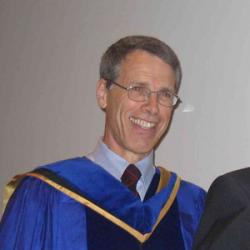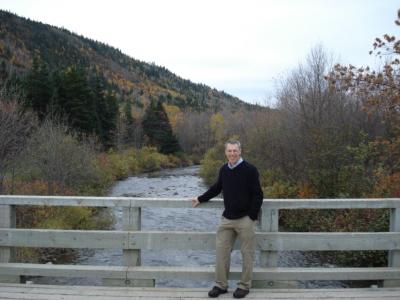Professor Emeritus

Contact Information
Email: peter.hodson@queensu.ca
Mailing Address:
Biosciences Complex
Queen's University
Kingston, Ontario, Canada
K7L 3N6
*Dr. Hodson is no longer taking on new research grants or trainees*
Supervising

Completed SES PhD students
Julie Adams (2022)
Completed MES Students
Tamzin El-Fityani (2010)
Shirin Fallahtafti (2011)
Anna Graham (2012)
Helen Power (2013)
plus numerous MSc and PhD students from Biology, Chemistry and Civil Engineering.
Academic Training
Ph.D., Zoology, University of Guelph 1974
M.Sc., Biology, University of New Brunswick 1970
B.Sc., Physiology, McGill University 1968
Current Research
Fish Toxicology
Current and Past Projects:
-
Role of hyporheic flows in fate, distribution, and effects of oil spilled to rivers.
-
Toxicity of crude and refined oils and diluted bitumen to fish.
-
Effect of chemical dispersants on oil toxicity.
-
Toxicity test methods for crude and refined oils and diluted bitumen.
-
The use of fluorescence spectrometry to characterize solutions of oil in water.
-
The identification of PAC in crude and refined oils that are toxic to fish.
-
Structure-activity relationships for the embryotoxicity of petrogenic alkylated polycyclic aromatic compounds (PACs).
-
The role of CYP1A metabolism in PAC toxicity to fish.
-
Biomarkers of PAC exposure and toxicity.
My research is relevant to the ecological risk assessment of PACs from oil, coal tar, creosote, soot and the by-products of microbial degradation of resin acids from pulp mill effluents. I have also assessed: the transfer of mercury from point sources and contaminated sediments through aquatic food webs of the St. Lawrence River; the contamination of St. Lawrence River sediments by pesticides used at EXPO 67; and the potential role of chemical contamination in the declining abundance of American eel in Lake Ontario.
My most recent research investigated the role of hyporheic flows in transporting oil droplets from surface waters of rivers into porous bed sediments where fish spawn. Funded by NSERC and supported by Environment Canada and Northwest Hydraulics Inc, it was an interdisciplinary and collaborative project with Ana daSilva (CIVL), Stephen Brown (CHEM, SES), Kevin Mumford (CIVL) and Allison Rutter (ASE, SES). Hyporheic flows are currents of water that move through porous gravel sediments due to pressure gradients caused by the flow of rivers over uneven bottom features of rivers. Julie Adams (PhD, Environmental Studies) assessed the toxicity to fish embryos of petroleum hydrocarbons that dissolve from stranded oil droplets in sediments. She developed laboratory models of river sediments contaminated by oil droplets and demonstrated that PACs released from oil were bioavailable to trout at concentrations that are embryotoxic (See Adams et al 2021).
My most recent project has been a textbook on Ecotoxicology with Peter Campbell (INRS), Pamela Welbourn (Queen’s) and David Wright (U. of Maryland), published by Cambridge University Press in 2022: ().
Past research has been supported by the Natural Sciences and Engineering Research Council (NSERC), research contracts from the Centre for Offshore Oil and Gas Environmental Research (COOGER), Department of Fisheries and Oceans and the Ontario Ministry of the Environment's Best in Science program. Collaborations have included scientists at: Queen’s University; the U. of Waterloo; the U. de Québec à Rimouski; the U. of Maine; the Universities of Jyvaskyla and Joensuu in Finland; Environment and Climate Change Canada; the Department of Fisheries and Oceans (DFO), and the US National Oceanic and Atmospheric Administration.
Service
For the past six years I have contributed lectures to ecotoxicology courses at Queen’s School of Environmental Studies and have been an invited member of several technical committees:
-
On-line workshop: Modernizing Chemical Response to Oil Spills: Ecological Effects Research Forum (CROSERF) Aquatic Toxicity Testing Protocols, March 2, 2021. Hosted by the Huntsman Marine Laboratory, St. Andrew’s NB.
-
Invited presentation: Adams, J.E. and P.V. Hodson 2021. Do we need ‘standard’ oil toxicity tests or standard methods for conducting oil toxicity tests?
-
-
A six-session on-line National Science Advisory Workshop: State of Knowledge on Chemical Dispersants for Canadian Marine Oil Spills, March 1 – 12, 2021. Hosted by Fisheries and Oceans Canada, Canadian Science Advisory Secretariat (CSAS).
-
The Fisheries and Oceans Canada Multi-Partner Oil Spill Research Initiative (MPRI) Advisory Committee, 2018-2021.
-
The Queen’s Beatty Water Research Centre Research Advisory Committee, 2014-2021.
-
The River Institute Research Advisory Committee, St. Lawrence River Institute, Cornwall ON, 2010-2021.
-
A Royal Society of Canada Expert Panel on The Behaviour and Environmental Impacts of Crude Oil Released into Aqueous Environments, January 13, 2015-June 30, 2015.
Current Teaching at Queen's
-
Guest Lecturer – ENSC 201; ENSC 203
(bold = students and PDFs)
- Campbell, P.G.C., Hodson, P.V., Welbourn, P.M., Wright, D.A., 2022. Ecotoxicology. Cambridge University Press, Cambridge, United Kingdom. 596 pp. Online ISBN: 9781108876605; Hardback ISBN: 9781108834698; Paperback ISBN: 9781108819732; DOI 10.1017/9781108819732 https://www.cambridge.org/highereducation/books/ecotoxicology/809CA85729E2E678638FB683AD7D77E7#overview
- Welbourn, P.M., Hodson, P.V. 2022. The History and Emergence of Ecotoxicology as a Science. Chapter 1, pp 3-19 in: Campbell, P.G.C., Hodson, P.V., Welbourn, P.M., Wright, D.A. (Eds), 2022. Ecotoxicology. Cambridge University Press, Cambridge, United Kingdom.
- Hodson, P.V., Wright, D.A. Measuring Toxicity. 2022. Chapter 2, pp 23-59 in: Campbell, P.G.C., Hodson, P.V., Welbourn, P.M., Wright, D.A. (Eds) Ecotoxicology. Cambridge University Press, Cambridge, United Kingdom
- Campbell, P.G.C., Hodson, P.V., Welbourn, P.M., Wright, D.A. 2022. Contaminant Uptake, and Bioaccumulation: Mechanisms, Kinetics and Modelling, Chapter 3, pp 61-97 in: Campbell, P.G.C., Hodson, P.V., Welbourn, P.M., Wright, D.A. (Eds) Ecotoxicology. Cambridge University Press, Cambridge, United Kingdom.
- Hodson, P.V., Wright, D.A. 2022. Methods in Ecotoxicology. Chapter 4, pp 99-138 in: Campbell, P.G.C., Hodson, P.V., Welbourn, P.M., Wright, D.A. (Eds) Ecotoxicology. Cambridge University Press, Cambridge, United Kingdom
- Metcalfe, C.D., Wright, D.A., and Hodson, P.V. 2022. Organics. Chapter 7, pp 275-326 in: Campbell, P.G.C., Hodson, P.V., Welbourn, P.M., Wright, D.A. (Eds) Ecotoxicology. Cambridge University Press, Cambridge, United Kingdom.
- Welbourn, P.M., Campbell, P.G.C., Hodson, P.V., Metcalfe, C.D. 2022. Complex Issues, Multiple Stressors and Lessons Learned. Chapter 10, pp 411- 454 in: Campbell, P.G.C., Hodson, P.V., Welbourn, P.M., Wright, D.A. (Eds) Ecotoxicology. Cambridge University Press, Cambridge, United Kingdom.
- Hodson, P.V., Welbourn, P.M. and Campbell, P.G.C. 2022. Regulatory Toxicology and Ecological Risk Assessment. Chapter 12, pp 457-486 in: Campbell, P.G.C., Hodson, P.V., Welbourn, P.M., Wright, D.A. (Eds) Ecotoxicology. Cambridge University Press, Cambridge, United Kingdom.
- Welbourn, P.M., Hodson, P.V. 2022. Recovery of Contaminated Sites. Chapter 13, pp 487-514 in: Campbell, P.G.C., Hodson, P.V., Welbourn, P.M., Wright, D.A. (Eds) Ecotoxicology. Cambridge University Press, Cambridge, United Kingdom.
- Marvin, C.H., Berthiaume, A., Burniston, D.A., Chibwe, L., Dove, A., Evans, M., Hewitt, M., Hodson, P.V., Muir, D.C.G., Parrott, J., Thomas, P.J., Tomy, G.T., 2021. Polycyclic aromatic compounds in the Canadian Environment: Aquatic and terrestrial environments. Environmental Pollution, 117442
- Adams, J.E., Brown, R.S. and Hodson, P.V. 2021. The bioavailability of oil droplets trapped in river gravel by hyporheic flows. Environmental Pollution 269, 116110
- Hodson, P.V., Wallace, S.J., de Solla, S.R., Head, J.A., Hepditch, S.L.J., Parrott, J.L., Thomas, P.J., Berthiaume, A., Langlois, V.S., 2020. Polycyclic aromatic compounds (PACs) in the Canadian environment: The challenges of ecological risk assessments. Environmental Pollution 266:115165 https://doi.org/10.1016/j.envpol.2020.115165
- Adams, J.E., Madison, B.N., Charbonneau, K., Sereneo, M., Baillon, L., Langlois,V.S., Brown, R.S., Hodson, P.V. 2020. Effects on trout alevins of chronic exposures to chemically-dispersed Access Western Blend and Cold Lake Blend dilbits. Environmental Toxicology and Chemistry 39:1620-1633. https://doi.org/10.1002/etc.4747
- Wallace S.J., de Solla, S.R., Head, J., Hodson, P.V., Parrott, J.L., Thomas, P.J., Langlois, V.S. 2020. Polycyclic aromatic compounds (PACs) in the Canadian environment: Exposure and effects on wildlife. Environmental Pollution 265:114863 https://doi.org/10.1016/j.envpol.2020.114863
- Madison, B.N., Wallace, S.J., Zhang, J., Hodson, P.V., Langlois, V.S. 2020. Transcriptional responses in newly-hatched Japanese medaka (Oryzias latipes) associated with developmental malformations following diluted bitumen exposure. Comparative Biochemistry and Physiology - Part D: Genomics and Proteomics 35:100685. https://doi.org/10.1016/j.cbd.2020.100685
- Honkanen, J.O., Rees, C.B., Kukkonen, J.V.K. and Hodson, P.V. 2020. Temperature determines the rate at which retene affects fish embryos, not the concentration that is toxic. Aquatic Toxicology 222:105471 https://doi.org/10.1016/j.aquatox.2020.105471
- Hodson, PV, Adams, J., Brown, RS. 2019. Oil toxicity test methods must be improved. Environmental Toxicology and Chemistry 38:302-311.
- Belpaire, C., Pierron, F., Hodson, P.V., Freese, M. 2019. Impact of chemical pollution on Atlantic eels: facts, research needs and implications for management. Current Opinion in Environmental Science & Health 11:26-36.
- McDonnell, D., Madison, B.N., Baillon, L., Wallace, S.J., Brown, R.S., Hodson, P.V., S. Langlois, V.S. 2018. Comparative toxicity of two diluted bitumens to developing yellow perch (Perca flavescens). Sciences of the Total Environment 655, 977-985. https://doi.org/https://doi.org/10.1016/j.scitotenv.2018.11.199 .
- Alsaadi, F.M., Madison, B.N., Brown, R.S. Hodson, P.V., Langlois, V.S. 2018. Morphological and molecular effects of two diluted bitumens on developing fathead minnow (Pimephales promelas). Aquatic Toxicology 204:107-116.
- Hoobin, S.J., Byer, J.D., Alaee, M., Brown R.S. and Hodson, P.V. 2018. Dioxin-like contaminants are no longer a risk to the American eel (Anguilla rostrata) in Lake Ontario. Environmental Contamination and Toxicology 37:1061–1070.
- Alsaadi, F., Hodson, P. V, & Langlois, V. S. 2018. An Embryonic Field of Study: The aquatic fate and toxicity of diluted bitumen. Bulletin of Environmental Contamination and Toxicology. 100:8–13. https://doi.org/10.1007/s00128-017-2239-7.
- Bloch, S.R., Kim, J.J., Pham, P.H., Hodson, P.V., Lee, L.E.J., and Bols, N.C. 2017. Responses of an American eel brain endothelial-like cell line to selenium deprivation and to selenite, selenate and selenomethionine additions in different exposure media. In Vitro Cell. & Developmental Biology – Animal. 53:940-953.
- Madison, B.N., P.V. Hodson and V.S. Langlois. 2017. Cold Lake Blend diluted bitumen toxicity to the early development of Japanese medaka. Environmental Pollution 225:579-586.
- Hodson, P.V. 2017. The toxicity to fish embryos of PAH in crude and refined oils. Archives of Environmental Contamination and Toxicology 73:12-18. http://doi.org10.1007/s00244-016-0357-6
- Adams, J., Charbonneau, K., Tuori, D., Brown, R.S. and Hodson, P.V. 2017. Review of Methods for Measuring the Toxicity to Aquatic Organisms of the Water Accommodated Fraction (WAF) and Chemically-Enhanced Water Accommodated Fraction (CEWAF) of petroleum. DFO Can. Sci. Advis. Sec. Res. Doc. 2017/064. xi + 110 p. http://www.dfo-mpo.gc.ca/csas-sccs/Publications/ResDocs-DocRech/2017/201...
- Adams, J., Charbonneau, K., Tuori, D., Brown, R.S., Hodson, P.V. 2017. The case for standardizing Oil Toxicity Test Methods. pp 441-462, In : Proc 40th Arctic and Marine Oilspill Program Tech Seminar, Ottawa, ON. Environmental Science and Technology Division, Environment and Climate Change Canada, Ottawa
- Pelletier, M., El-Fityani, T., Graham, A., Rutter, A., Michelutti, N., Zeng, D.M., Sivarajah, B., Smol, J.P., and Hodson, P.V. 2016. Tracking pesticide use in the Saint Lawrence River and its ecological impacts during the World Exhibition of 1967 in Montreal, Canada. Science of the Total Environment 572:498-507.
- Beyer, J., Trannum, H.C., Bakke, T., Hodson, P.V, and Collier, T. 2016. Environmental effects of the Deepwater Horizon oil spill: a review. Marine Pollution Bulletin 110:28-51.
- Vehniäinen, E-R., Bremer, K., Scott, J.A., Junttila, S., Laiho, L., Gyenesei, A., Hodson, P.V., and Oikari, A.O.J. 2016. Retene causes multifunctional transcriptomic changes in the heart of rainbow trout (Oncorhynchus mykiss) embryos. Environmental Toxicology and Pharmacology 41:95-102. http://www.sciencedirect.com/science/article/pii/S1382668915301319
- Rigaud, C., Couillard, C.M., Pellerin, J., Légaré, B., Byer, J.D., Alaee, M., Lebeuf, M.,. Casselman, J.M., Hodson, P.V. 2016 Temporal variations in embryotoxicity of Lake Ontario American eel (Anguilla rostrata) extracts to developing Fundulus heteroclitus. Science of the Total Environment 541:765-776
ALSO: https://scholar.google.com/citations?view_op=list_works&hl=en&user=BEtgS7EAAAAJ
https://www.researchgate.net/scientific-contributions/39156718_Peter_V_Hodson
